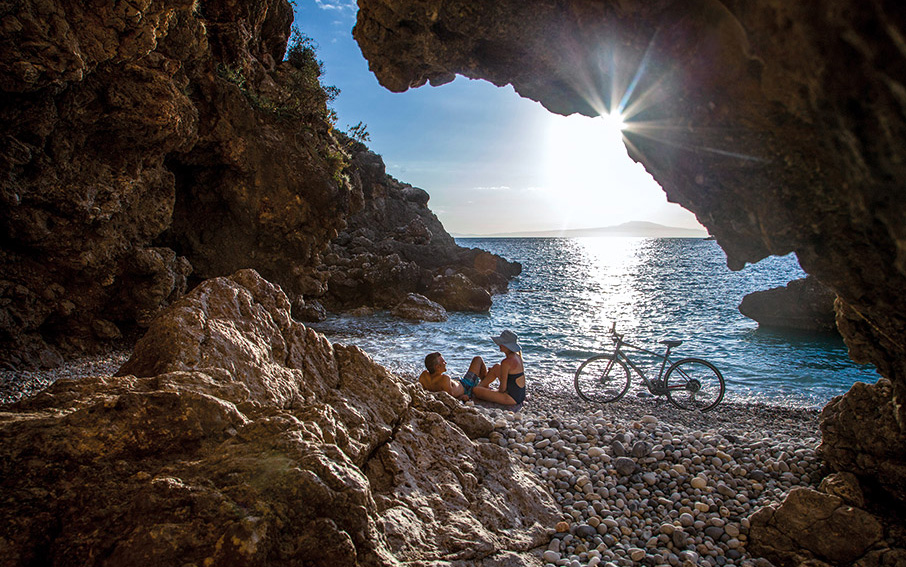Was the gorge of Foneas always so verdant? Was the return from Kitries to the main road when we returned from the ouzerie always so steep? Why had we never noticed the impressive peak above Agios Nikonas?
All these questions come to mind as we cycle through Messinian Mani. We discover new images and settings that have been here all along, even though we had not noticed them before.
Our perception of the environment changes on a bicycle, you notice different things. The same road acquires value, nature comes to the forefront, cultural sites are less important – you only retain the ones that truly interest you. And there’s the feeling of absolute freedom.
In addition, time is not wasted on pointless detours and you do not lose track of things: if you relax too much as you cycle things inevitably get challenging, and you also need to meet the daily goal before sunset, as the provincial roads in Greece are not really dependable.
Of course, the popularity of cycling is growing and local authorities need to take this into account.
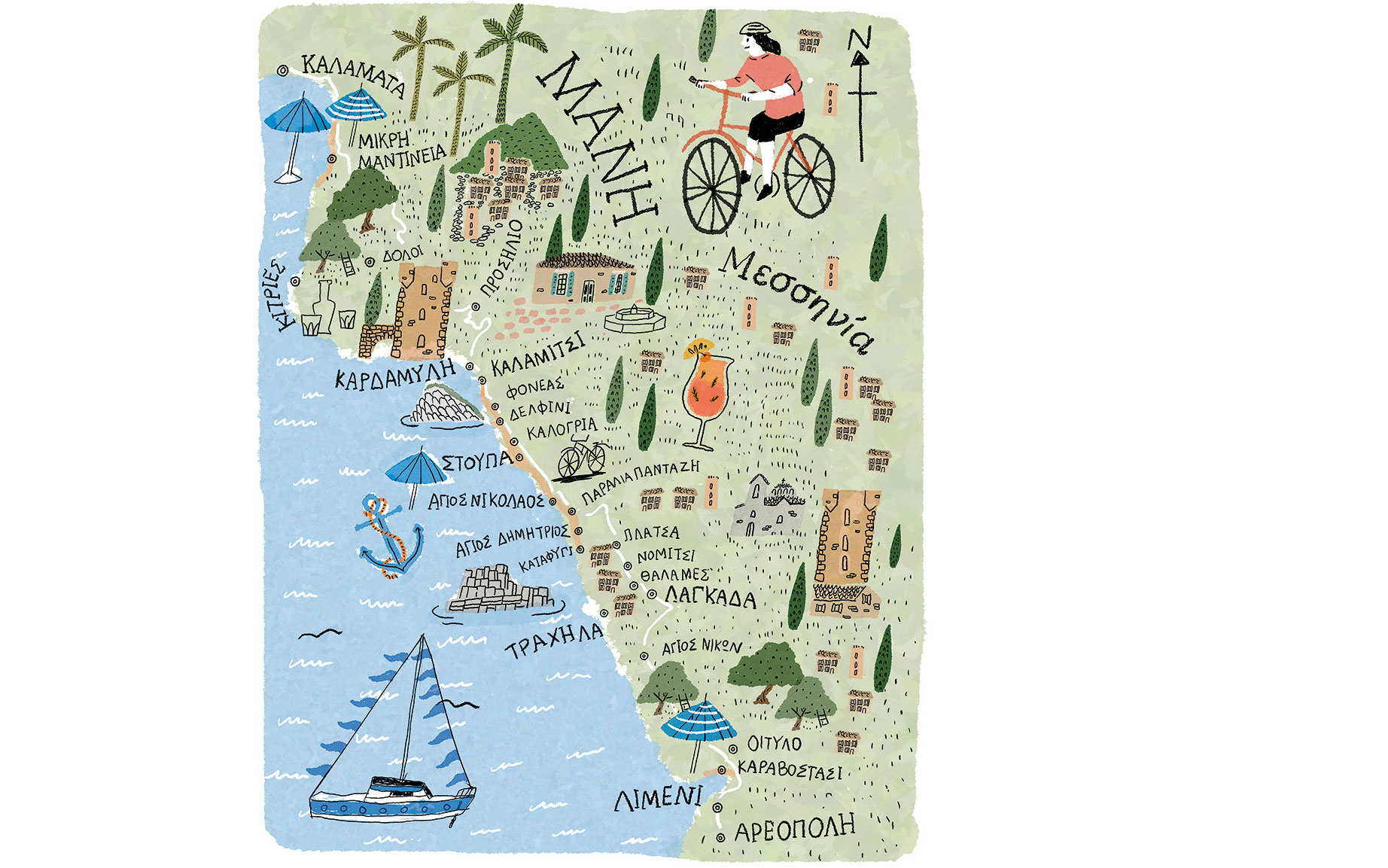
© ILLUSTRATION: Filippos Avramidis
Kalamata-Areopoli, 100 km, 2 days, 5 bicycles, and one support vehicle we take turns driving. A route that traverses Messinian (or Western) Mani and leads to Lakonian (or Eastern) Mani. The concept was to reach Cape Tenaro having traversed 150 km in three days, but an unexpected storm disturbed our plans. Even so, this is still one of the beautiful cycling routes in Greece.
The landscape combines mountain and sea, the setting changes often, the road is rather well-kept with some problematic spots that could be improved, yet without abrupt differences in height, traversing beaches and quaint villages – in fact, ideal for a thoroughly enjoyable bike trip.
Kalamata is our starting point. The bicycle lane runs along Navarinou street, lined with palm trees, the sandy beach and various cafe-restaurants. As is the case in most towns, it is no surprise that it is filled with pedestrians and sometimes even parked cars.
Verga Beach – Mikri Mantineia – Sadova – Kitries: early swimmers have already arrived at these coastal suburbs, but traffic is very much reduced in the early morning. When summer is in full swing, more attention will be needed.
We chose this route to ride by the sea (alternatively we would take the central road, uphill) but now we are paying the price: the road ends at Kitries and we need to ascend a steep and painful incline to Malta village.
We stop in Kitries for Gaitanaros’ delicious seafood, and equip ourselves with courage and grit to “clamber” up the olive groves at Doloi.

© Olga Charami
Views
This cycling trip offers views everywhere. The road heading downhill to Kardamili begins with an impressive view, as the town is nestled among cypress trees and olive groves, with the islet of Meropi in the distance. The road is wide and well-paved, and the support vehicle accompanying us offers the required safety to deal with car speeding, and also carries the weight of our backpacks.
The breeze on Mount Taygetus meets the gusts of the Messinian Gulf and accompanies us to Old Kardamili. This old village features stone houses and the historic complex of Agios Spyridon (18th century) and the famed Tower of Troupakis-Mourtzinos, today a museum, which offers insight into Maniot architecture and idiosyncrasy.
They say that Kolokotronis came to this courtyard to organise fighters and set off with Maniots on 22 March, 1821, to liberate Kalamata.
The afternoon light shines on the charming stone and limestone structures. The shadows get longer. We are the tower’s warriors now, making plans for our cycling route. For the time being, we will occupy Liodentra, a wonderful traditional guesthouse with independent structures, a private garden and swimming pool. There is no better choice for a group, especially after such an excursion. Our feet are dipped in water immediately – and this is no luxury treatment, but necessary rehabilitation for cyclists.
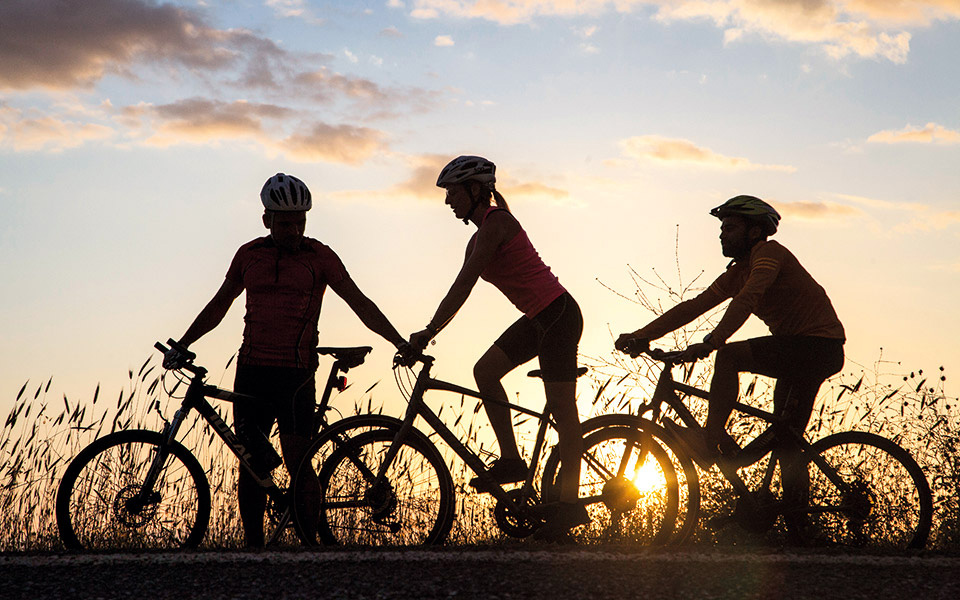
© Olga Charami
A different light
Anna makes us coffee at Cafe Androuvista, Nikos offers to carry our bicycles with his pick-up truck, Giannis Avrameas comes to greet us on the steps of 2407 Outdoor Experience. A keen cyclist, as his partner Sotiria Zoubou, they have been running an outdoor activity company in Kardamili and Stoupa for the last 13 years.
This is clearly a meeting point for the area’s cyclists, as two groups of cyclists have already stopped by to exchange pleasantries within minutes of our arrival. Kardamili is more lively than ever.
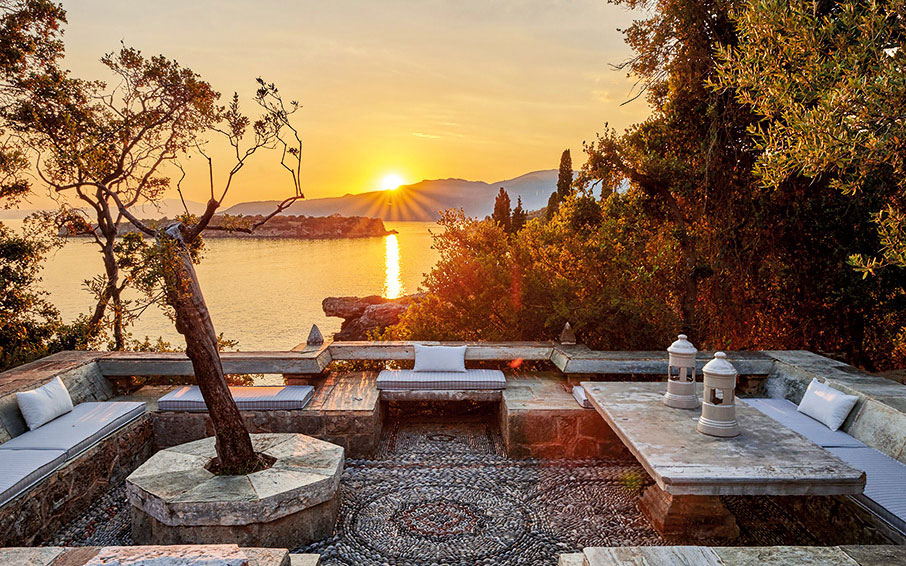
© STUDIO RESKOS
The Patrick Leigh Fermor residence
In contrast, there is absolute quiet in the residence of famed British author Patrick Leigh Fermor (1915-2011), in Kalamitsi. The olive trees acquire a golden sheen in the morning light, the aura is magical. Fermor chose the most beautiful part of the region to build the house he shared with his photographer wife, Joan, until the end of his long life.
The house was then bequeathed to the Benaki Museum to host academics and researchers. And so the house is offered to international universities throughout the year, except for three months in the summer when it is managed by Aria Hotels and available for rentals, so that its maintenance costs are covered.
The public can also visit the house and, despite the necessary interventions that may seem strange (such as the construction of the swimming pool and the adaptation of bedrooms), the beauty is still there.
You really do not know where to sit first. We observe the architecture that so interested the travel writer: it seems to follow the layout of a monastery, with east-facing loggias and wooden ceilings, French-style windows, stoas and atriums. Incorporated into the landscape, outgoing, full of specially-designed spaces for groups – indeed, many people were hosted here all the time, from the finest intellectuals to fishermen from the village.
Fermor’s furniture and library are also still there. The fireplaces inspired by Persia, the ancient Greek stone fragments, the Aegean pebble mosaics he built with Hadjikyriakos-Ghikas, the marble rotonda from Venice, the molding from a balcony in Ilia that became a garden table. A mosaic from his travels, where he has even studied how the view is framed from the windows and how the Greek light diffuses in the spaces.
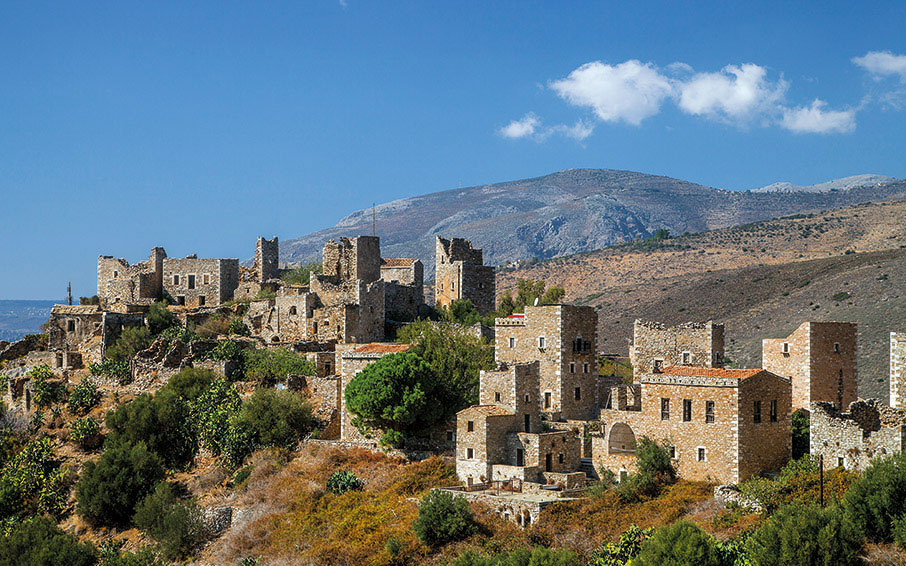
© Olga Charami
It is this light of Western Mani that makes our journey so special, but it also blinds drivers: the red blinking lights on our bicycles are always on. The vegetation blanketing the slopes of Mount Taygetus seems to be the most intense green we have ever seen, the spring wildflowers are blooming, the sea sparkles alongside us. We pedal with the bees and on the beach of Foneas, boasting rocks and impressive caves, we take our first swim.
The beaches of Delfinia, Kalogria, and cosmopolitan Stoupa await, as from Stoupa begins a lovely concrete bicycle lane. Almost three kilometers without the sound of any motor vehicle, just above the sea until the small port of Agios Nikolaos. Fishermen gather in front of their caiques and people walk up and down the promenade. The beach bar on Pantazi beach is full.
We ride through imposing red rocks and prickly pear trees on the way to Trachila, where the road ends at a secret little port. This is Trachila, isolated, with stone houses that have recently been inhabited once again by the younger generation, who may or may not hail from here. Of course, Trachila is famed for its salt, sourced from natural salt pans used by locals and by inhabitants of Hotasia, a neighboring village.
Backtracking to Pantazi beach, we go up to the main road and prepare for the great ascent. From here to Platsa we must traverse 7 km as we ascend 450 meters in height – the hardest section of the route. A fortunate turn of fate… it was my turn to drive the support vehicle!
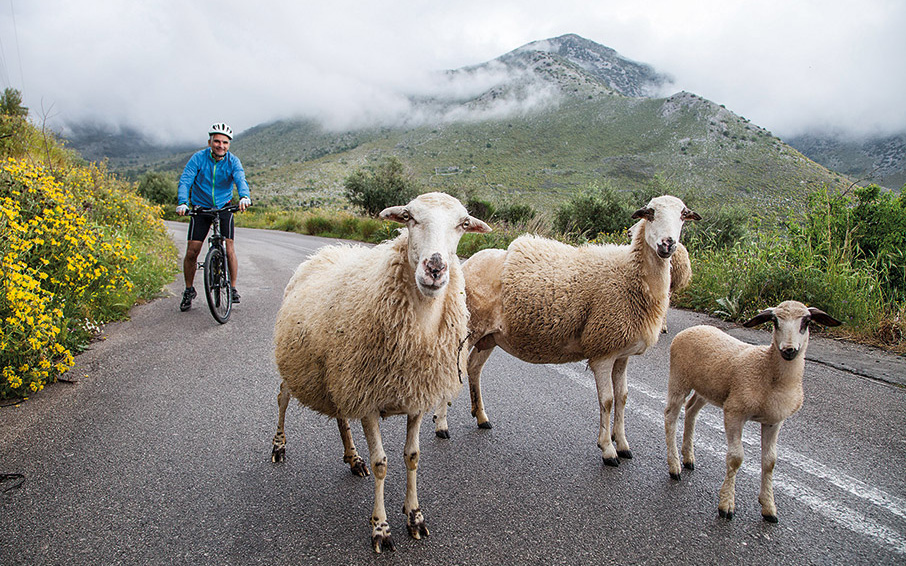
© Olga Charami
The Route to Lakonia
Everyone stops at Nomitsi for its gorgeous Byzantine chapels lining the street, while the villages of Thalames and Lagada are ideal for taking walks through the narrow streets and towers, of which the five-storey Tower of Kapitsinos in Lagada stands out.
Once again we cycle past numerous olive trees, traditional stone walls and flintstones – a sparse, impressive landscape that reaches all the way to the peak and church of Agios Nikonas. The village was once called Poliana, which means “flat” in Slavic, and indeed it is flat even though my tired legs feel it is uphill.
And so we arrive at Itylo, which of course deserves a stop. You must visit the church of Agios Giorgis or the Monastery of Dekoulon to observe the amazing Saint-Stratigos, the patron saint of Mani. It is the Archangel Michael, in military costume, holding a sword, an infant (symbol of the soul) and apotropaic symbols. He also indicates that we have just entered the “rougher” part of Mani – the Eastern part.
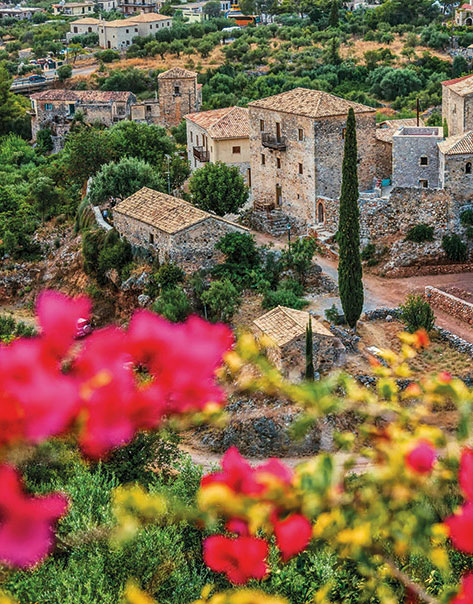
© Perikles Merakos
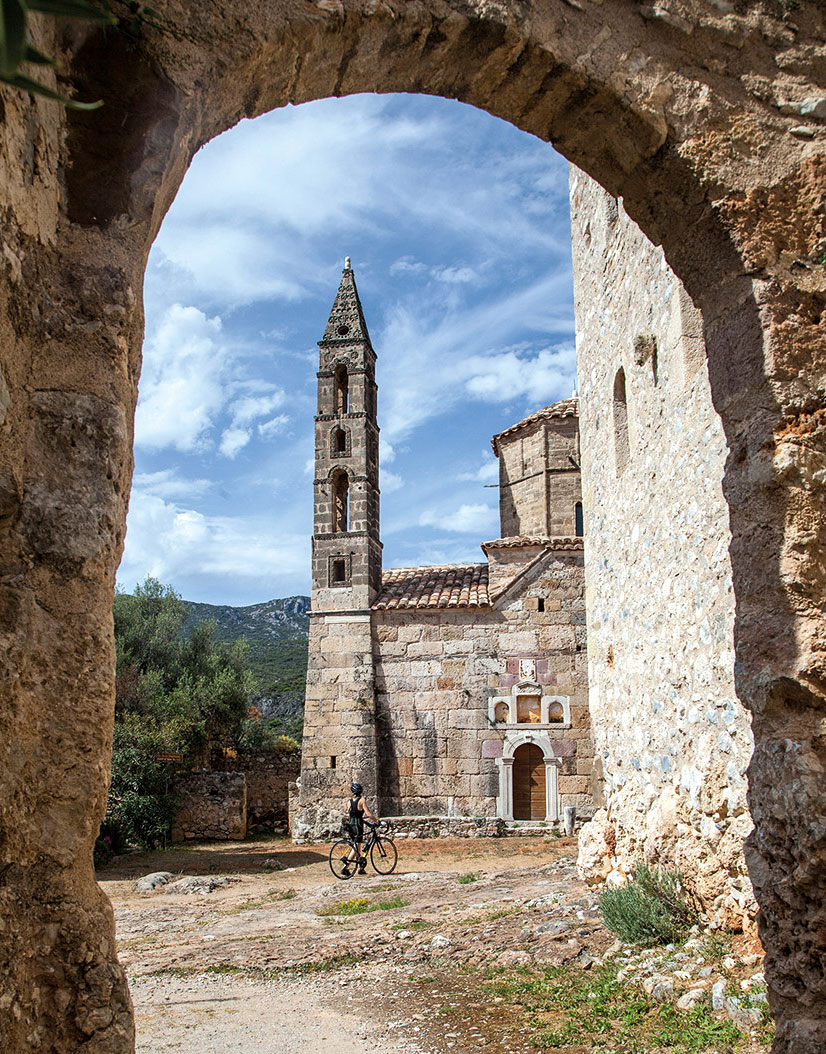
© Olga Charami
The enjoyable downhill slope unfolds before us, leading to Karavostasi, Neo Itylo and Limeni, a former pirate hideout that is now a popular summer hotspot.
Old friends rush to meet us. Giannis Magouras grows organic prickly pears, produces and packages En Mani juices, and we quench our thirst with the new ginger and prickly pear flavor; Giannis Kotileas of Mani Watersports offers us a sea excursion that involves diving and kayaking, but who has the strength for that? Dimitris Vellopoulos and Calliopi Koutroubi at ManiBella read Maniot fairy tales on the beach and organise activities for children visiting the area, and Pierros Tsatsoulis, who produces a fine “fleur de sel” from Mani that is 99.7% pure, offers to take us to Areopoli on his pickup truck so we can avoid the final uphill stretch. We all declined his offer.
We enter Areopoli as liberators, with Maniot flags featuring the Spartan motto “I tan i epi tas” (with this, or on this) flying over our heads.
Through the narrow streets of the historic center, through the restored tower-houses, through bars with well-dressed visitors and through groups of Maniot “chieftains” bedecked with guns for a film or anniversary event about the Revolution, as they say this is where it all began, we sit proudly on the steps of the historic Taxiarchon church, eating pulled pitas (pastry with cheese and/or honey) from the town bakery and drinking our first beers. And do not think beers are a reward for cyclists – they provide us with valuable electrolytes!
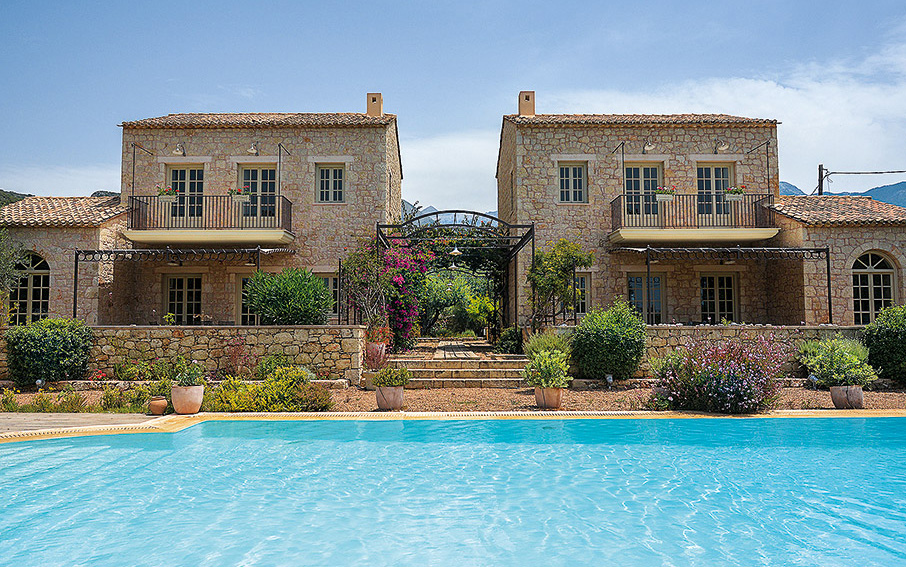
Where to Stay
Liodentra (Kardamili, tel. 27210-73919, ariahotels.gr, from 800 euros for the entire complex, houses 10-14 people). A decor featuring 19th century chests, light fixtures from England, and French gravures creates a wonderful atmosphere. Located on Ritsa beach, the verdant garden with a swimming pool and three structures seems like the ideal option for big groups (or not), since there is one single-storey residence and two two-storey residences available. Each one is made of stone and wood, in complete harmony with the environment and true to traditional architecture. Nina Pastra has taken over the management, in collaboration with Aria Hotels.
Antares (Omales, tel, 27330-51700, antareshotel.gr, from 160 euros including breakfast). On the slopes of Areopoli this guesthouse features a restored complex of tower houses, and seems like a secret hiding place. From its name, which refers to the constellation, to the quiet balconies with wonderful views, the sweet-scented garden and refined breakfast, everything here exudes a sense of caring and hospitality.
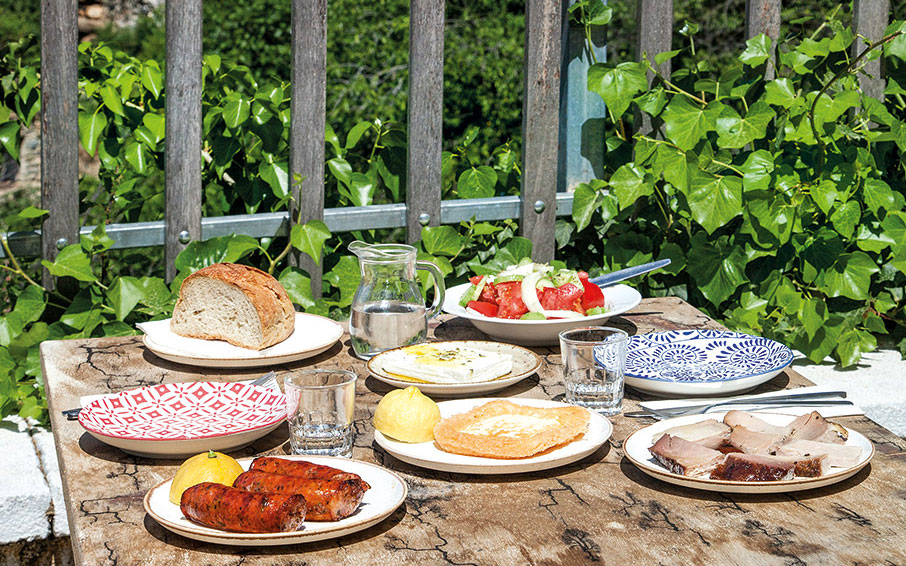
Food & Drink
Lela’s taverna is a classic offering in Kardamili (tel. 27210-73541) and is especially known for its delicious magirefta (stove or oven cooked food) that you can enjoy on its lovely patio, by the sea, while Elies (tel. 27210-73140) is also an good choice. In its third year of operations, Tikla (tel, 27210-74444) is gaining a faithful following with this ethnic aesthetic and particular dishes.
For fresh seafood and fish opt for Gaitanaros in Kitries (tel. 27210-58370) and in Agios Nikolaos, while Elli’s taverna has great magirefta (tel. 6983-294889).
At Pigi you will find the taverna of Barba Lias (or Stathis) in a wonderful veranda-patio, next to the church and under the plane tree, where you will take your pick from a platter of home-made meze (tel. 6932-214562). You may also enjoy good food in a special space at Magemenos Pyrgos (tel. 27210-74420) in Thalames.
For coffee and snacks in Kardamili try Androuvista (tel. 27210-73788), where Anna prepares sweets and sandwiches using local products. Aquarella (tel. 27210-75010) is an all-day hangout on the beach, but ideal for sunset cocktails.
For Cyclists
Your guy is called Giannis Avrameas and his company is called 2407 Outdoor Experience. He organises a variety of activities, but is known for hiking and cycling excursions. This is where you may rent bicycles, get useful information, participate in one of the cycling routes, and request a support vehicle or van transportation (2407m.com)
The cyclical route that begins in Stoupa and continues uphill to Mount Taygetus, past the villages of Platsa, Milia, Karyovouni, Saidona, Exohori and Proastio, to return to Stoupa, has earned the name “the big loop.” If you can take extreme uphill inclines, it is worth a try.
Cycling Guide: Avoid cycling at night, as there is limited lighting on the provincial road network. Do not make it difficult for drivers so as to avoid dangerous overtaking. Use a blinking red light during the day and the night, and wear vibrant colors. You will not face issues with animals in Mani: wild boar roam only at night, while the shepherd dogs are usually very friendly. Avoid running over any snakes you encounter on the way – they pose no danger to you.
Equipment: Always wear a helmet, cycling glasses to protect from flying bugs and bring with you a pump, a spare tube, water or isotonic beverages, a light snack, a first aid kit, sunscreen, and a windbreaker.

